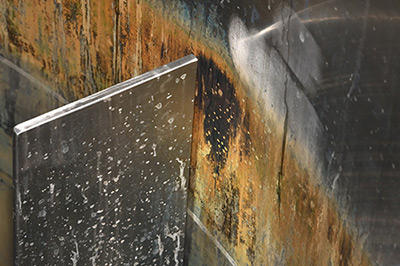Rouging and its Consequences
 Let’s talk about “rouge” (French for ‘red’) and I don’t mean the cosmetic term…
Let’s talk about “rouge” (French for ‘red’) and I don’t mean the cosmetic term…
Rouging is a symptom of corrosion that occurs on stainless steel due to iron contamination. Often unpredictable and imperfectly understood, the rouge is composed of corrosion products that include hydrogen and iron oxides in different states of oxidation.
Specific colors (or rouging) vary depending on the type of iron oxidation and is thought to be the result of a momentary deterioration within the passive surface. Another theory connects rouging to the interaction of passive layers that are high in chromium with water. The resulting corrosion depends on the chemical composition of the steel and its operating environment.
There are fundamentally three types of rouging:
-
- Type 1 – Red, Orange, Brown – This is the most common. Type 1 is rich in iron oxide with crystals forming on the surface of the metal. This type can be easily wiped off, but can also be dislodged while the product is being processed resulting in particulate contamination. These crystals start out at sizes smaller than a micron, but can easily grow to measure 100 microns (0.1mm).
- Type 2 – Gold, Red, Brown – This type of forms at the site it is discovered, and if dislodged, it may reveal the bright surface of the stainless steel underneath. It is generally caused by the presence of chlorides in the water and it often appears on surfaces where the passive layer has become weak or where passivation was never performed.
- Type 3 – Gray or Black – Also known as “scale” and dependent on the surface where it appears, this rouge is unique to high temperature, high purity steam systems, and is a form of magnetite. Type 3 typically gets darker as it grows and is formed by the iron interacting with hot water vapor binding with the oxygen to form a ferrous oxide, which gives it its black color, along with ferric oxide. When on a rough surface such as un-passivated, mechanically polished steels, it may appear loose and powdery. On a smooth surface, it can be shiny and is often detected when it appears on filters or autoclaved items.

There are various consequences from rouging that are a major concern including:
- Unsanitary finish on the surface of the metal – leading to contamination of the product being produced.
- Equipment malfunction – if left untreated, rouge can lead to structural damage of components or full even system failure.
- Process failure to meet specification – may lead to fines from government regulators.
Solution:
- Type 1 – This can simply be removed via a little ‘elbow grease’ and a specific non-abrasive chemical treatment then passivated for protection.
- Type 2 – It can be harder to remove than the similar-looking Type 1 rouge. It cannot simply be wiped off, but be treated with a de-rouging process. More severe cases may require chemical electropolishing to completely eliminate it from the surface. Regardless of the cleaning process used, the surface must be passivated afterward to restore the passive layer which will have been damaged by the rouge as well as the removal process.
- Type 3 – It may have a relatively high silica content which makes it more resistant to the usual chemical treatments. Often, more aggressive chemical treatments needed as well as mechanical polishing or electropolishing. Passivation is also an essential step to be taken after de-rouging.
These solutions can be completed by your maintenance team if they have the capabilities or through on-site service providers with mechanical polishing, electropolishing, and passivating capabilities.
Allegheny Surface Technology is your trusted provider of high-performance, ASTM and BPE compliant electropolishing, pickling, mechanical polishing, and passivation services. Specializing in both in-house and on-site stainless steel surface refinishing/refurbishment services, AST assures both the quality and reliability of our services through multi-step Quality Assurance and inspection protocols.
